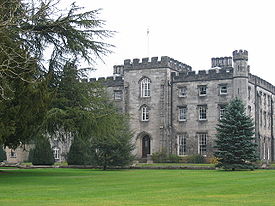
Tulliallan Castle
Encyclopedia

Kincardine
Kincardine or Kincardine-on-Forth is a small town located on the north shore of the Firth of Forth, in Fife, Scotland. The town was given the status of a Burgh of barony in 1663. It was at one time a reasonably prosperous minor port...
, Fife
Fife
Fife is a council area and former county of Scotland. It is situated between the Firth of Tay and the Firth of Forth, with inland boundaries to Perth and Kinross and Clackmannanshire...
, Scotland
Scotland
Scotland is a country that is part of the United Kingdom. Occupying the northern third of the island of Great Britain, it shares a border with England to the south and is bounded by the North Sea to the east, the Atlantic Ocean to the north and west, and the North Channel and Irish Sea to the...
.
It is the second structure to have the name (see below), and is a mixture of Gothic
Gothic architecture
Gothic architecture is a style of architecture that flourished during the high and late medieval period. It evolved from Romanesque architecture and was succeeded by Renaissance architecture....
and Italian style architecture set amid some 90 acres (36.4 ha) of parkland just north of where the Kincardine Bridge
Kincardine Bridge
The Kincardine Bridge is a road bridge crossing the Firth of Forth from Falkirk council area to Kincardine-on-Forth, Fife, Scotland.-History:The bridge was constructed between 1932 and 1936, designed by Donald Watson...
spans the Firth of Forth
Firth of Forth
The Firth of Forth is the estuary or firth of Scotland's River Forth, where it flows into the North Sea, between Fife to the north, and West Lothian, the City of Edinburgh and East Lothian to the south...
. It is the home of the Scottish Police College
Scottish Police College
The Scottish Police College, based at Tulliallan Castle, in Kincardine-on-Forth, provides basic training to all new recruits to the Scottish Police Forces....
and has been since 1954.
It was built in 1812-1820 for George Keith Elphinstone, Admiral Lord Keith one time senior officer of Lord Nelson, from money received from prize ships, by a labour force said to include French prisoners of war. During the Second World War its history took on a further international dimension when it was used by the Polish Armed Forces in the West
Polish Armed Forces in the West
Polish Armed Forces in the West refers to the Polish military formations formed to fight alongside the Western Allies against Nazi Germany and its allies...
as their headquarters in Scotland
Scotland
Scotland is a country that is part of the United Kingdom. Occupying the northern third of the island of Great Britain, it shares a border with England to the south and is bounded by the North Sea to the east, the Atlantic Ocean to the north and west, and the North Channel and Irish Sea to the...
.
Prior to the Second World War there was no central training for police officers in Scotland. After the war it was decided to centralise all police training and Tulliallan was the result.
Tulliallan, from the Gaelic Tulach-Aluin ('beautiful knoll') was purchased in 1950 by the then Scottish Home Department for £9,100. The building was modernised and renovated and the first courses for inspectors and sergeants began in 1954.
Over the years the site has been heavily modified to provide accommodation, catering, training and teaching facilities for the Scottish Police College.
The building is now used as the administrative head of the Scottish Police College and also provides the accommodation for the Director of the College.
An earlier structure about a half mile NW, Old Tulliallan Castle, was built by 1304, when it was ordered to be strengthened by Edward I of England
Edward I of England
Edward I , also known as Edward Longshanks and the Hammer of the Scots, was King of England from 1272 to 1307. The first son of Henry III, Edward was involved early in the political intrigues of his father's reign, which included an outright rebellion by the English barons...
, it then passed into the ownership of William Douglas, 1st Earl of Douglas
William Douglas, 1st Earl of Douglas
William Douglas, 1st Earl of Douglas was a Scottish magnate.-Early Life:William Douglas was the son of Sir Archibald Douglas and Beatrice Lindsay, and nephew of "Sir James the Good", Robert the Bruce's trusted deputy...
, and was granted by the Douglases to the Edmonstones,and thence to a junior branch of the Blackadders
Clan Blackadder
Clan Blackadder is a Scottish clan. The clan historically held lands near the Anglo-Scottish border.-Clan status:Today Clan Blackadder does not have a chief recognised by the Lord Lyon King of Arms, therefore the clan has no standing under Scots Law...
, and finally to the Bruce
Clan Bruce
Clan Bruce is a Scottish clan from Kincardine in Scotland. It was a Royal House in the 14th century, producing two kings of Scotland.-Origins of the Clan:...
s of Carnock. A fortified house with a keep
Keep
A keep is a type of fortified tower built within castles during the Middle Ages by European nobility. Scholars have debated the scope of the word keep, but usually consider it to refer to large towers in castles that were fortified residences, used as a refuge of last resort should the rest of the...
and rib-vaulted
Rib vault
The intersection of two or three barrel vaults produces a rib vault or ribbed vault when they are edged with an armature of piped masonry often carved in decorative patterns; compare groin vault, an older form of vault construction...
ground floor, it was abandoned in the seventeenth century.
See also
- Scottish Police CollegeScottish Police CollegeThe Scottish Police College, based at Tulliallan Castle, in Kincardine-on-Forth, provides basic training to all new recruits to the Scottish Police Forces....
- Gazetteer for Scotland entry for Old Tulliallan Castle

